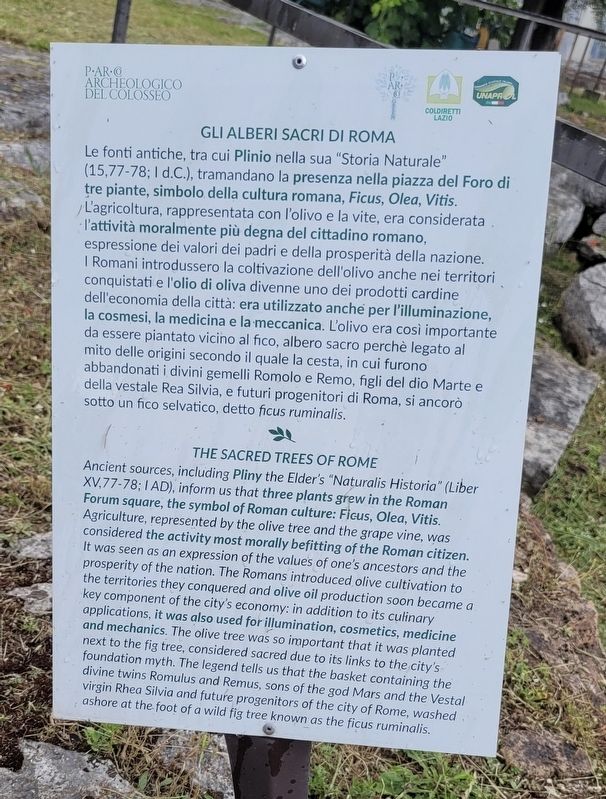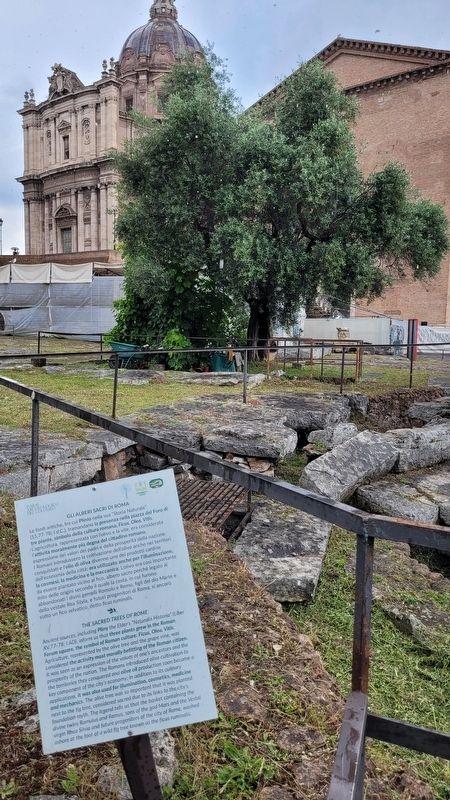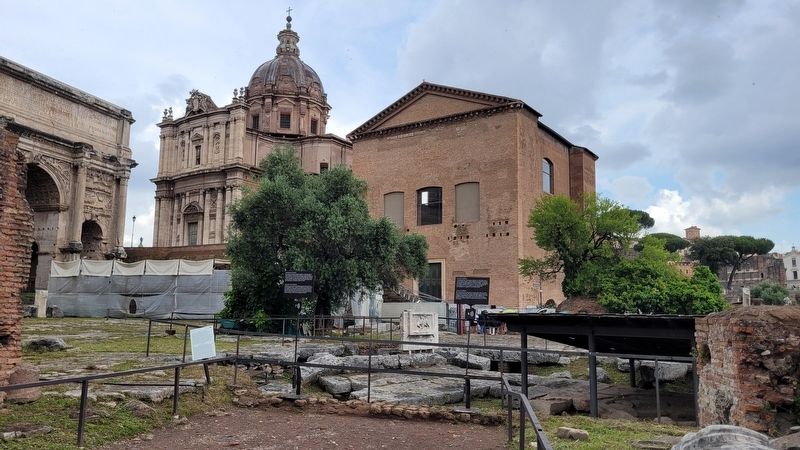Rione X Campitelli in Roma in Città metropolitana di Roma Capitale, Latium, Rome, Italy — Central Italy (Tyrrhenian Coast)
Gli Alberi Sacri di Roma / The Sacred Trees of Rome
Inscription.
Ancient sources, including Pliny the Elder's "Naturalis Historia" (Liber XV,77-78; I AD), inform us that three plants grew in the Roman Forum square, the symbol of Roman culture: Ficus, Olea, Vitis. Agriculture, represented by the olive tree and the grape vine, was considered the activity most morally befitting of the Roman citizen. It was seen as an expression of the values of one's ancestors and the prosperity of the nation. The Romans introduced olive cultivation to the territories they conquered and olive oil production soon became a key component of the city's economy: in addition to its culinary applications, it was also used for illumination, cosmetics, medicine and mechanics. The olive tree was so important that it was planted next to the fig tree, considered sacred due to its links to the city's foundation myth. The legend tells us that the basket containing the divine twins Romulus and Remus, sons of the god Mars and the Vestal virgin Rhea Silvia and future progenitors of the city of Rome, washed ashore at the foot of a wild fig tree known as the ficus ruminalis.
Erected by Parco Archeologico del Colosseo.
Topics. This historical marker is listed in these topic lists: Anthropology & Archaeology • Horticulture & Forestry.
Location. 41° 53.54′ N, 12° 29.1′ E. Marker is in Roma, Lazio (Latium, Rome), in Città metropolitana di Roma Capitale. It is in Rione X Campitelli. Marker is on Via Sacra. The marker is located west of the Arch of Titus in the Roman Forum. Touch for map. Marker is in this post office area: Roma, Lazio 00186, Italy. Touch for directions.
Other nearby markers. At least 8 other markers are within walking distance of this marker. Colonna di Foca / Column of Phocas (here, next to this marker); Lacus Curtius / Lake Curtius (here, next to this marker); Arco di Settimio Severo / Arch of Septimius Severus (a few steps from this marker); Basi Onorarie / Honorary Bases (within shouting distance of this marker); Basilica Giulia / Basilica Iulia (within shouting distance of this marker); Shrine of Venus Cloacina / Sacello di Venere Cloacina (within shouting distance of this marker); Umbilicus Urbis / The Focus of the City (within shouting distance of this marker); Veduta del Tempio Detto della Concordia / View of the So-called Temple of Concord (within shouting distance of this marker). Touch for a list and map of all markers in Roma.
More about this marker. The marker is located in the Parco Archeologico del Colosseo (Roman Forum Archaeological Park) and it does require an entry fee to visit.
Also see . . . Parco Archeologico del Colosseo. Roma Turismo (Submitted on August 23, 2023, by James Hulse of Medina, Texas.)
Credits. This page was last revised on August 24, 2023. It was originally submitted on August 23, 2023, by James Hulse of Medina, Texas. This page has been viewed 54 times since then and 14 times this year. Photos: 1, 2, 3. submitted on August 24, 2023, by James Hulse of Medina, Texas.


